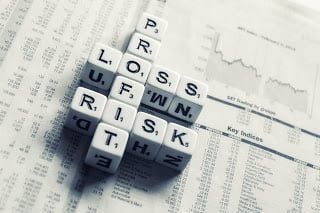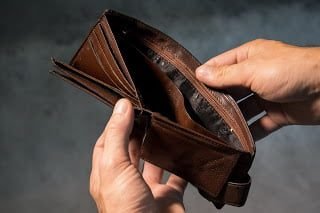Home » Blog » Getting Started Trading »
And Why is R So Important to Understand?
R in Trading is an objective way to think about success or failure in a trade. R expresses the (possible) return on a trade as a multiple of the risk taken on by that trade.
In my trading log, I register the amount of R I make. Also in my trading videos and ideas, I always talk about targets, for example, as 2R or 3R. You may have wondered why I am doing that. Why don’t I just talk about pips, points, or dollars risked, won or lost on a trade?
To answer these questions in full, we need to dive more deeply into the concept of R in trading. We will look into Risks, Returns, Probabilities and how these relate. Let’s go!
Table of Contents
- Risk
- Return
- The Reward to Risk ratio
- The Importance of Focusing on R in Trading
- Thinking About Probabilities
- Finding Your Perfect R
- Win Ratio
- Expectancy And The Risk of Ruin
- What Does This Mean in Practice?
- Further recommended reading
- Watch this
Risk
In trading, the distance between your trade entry and your stop-loss level is what defines your Risk.
Everything in life is Risk or Risky. If you start a new job, take on a new project, or decide to get married or move to another city, there is always a chance that things will go wrong. Still, we accept the risks, because of the possible benefits our actions can bring us. When we take these everyday life risks we consider how much we can handle if things go wrong.
Sometimes if the risks are too big to handle we take out insurance, which ensures our downside is limited. This is no different in trading. Trading is no riskier than any other activity in life if you know what you are doing.
Just like in real life you can take out insurance to limit your trades downside. This is done, for example, by placing a stop-loss order, which will take you out of a position automatically if a certain level is reached.
Return
Returns are wonderful. In fact, it is what most novice traders are focused on when they start to trade. It is like that guy that is starting a business. Of course, he is fully convinced he is going to be a millionaire within a year.
However, a well-versed businessman would first think about the potential risks that also come with the business. He would try to gauge the returns in comparison to the risks. And only decide to go ahead if the possible returns are worth the risks taken.
So returns in itself mean nothing. Someone can make me a proposition to make 100.000 US Dollars a year selling ice-cream to kids or to make a million US Dollars selling guns to rebels. The later has a higher return but is it a better deal? I don’t think so, but it is different for everyone.
The Reward to Risk ratio

In trading, as well as in life, we always want to consider the possible returns of our actions as a multiple of the risks that we need to take to possibly make the returns. Therefore we need to focus on risk first and return second.
By doing this we can express the result of our actions as a ratio of the returns to the risks taken, also known as the Reward to Risk ratio or RtoR ratio, or simply R. If our action fails, we will always only lose 1R. Our returns will always be a multiple of this 1R.
The Importance of Focusing on R in Trading
Focusing on R in trading is important because it makes us focus on Risks First and Returns second. Using R we can also determine if a trade is worth taking or not. Or if there are many opportunities at once, we can take the ones with the highest Return to Risk Ratio.
Thinking About Probabilities
 |
| Probabilities |
There is a relationship between the R to R ratio, R, and the probability of a trade working out or not. If you target a very low R multiple, let’s say below 1, then the probability of your trade hitting its target is higher than when you target a higher, let’s say 5, R.
This is how scalping robots, like the famous FapTurbo, would make consistent small profits, only to lose everything and more on one trade, that went the wrong way. Therefore, we could say that trading strategies with typically low R trades can look good on paper and in real live trading, until they blow up.
This is also exactly how Wall street types make consistent money. And when they blow up, and they always do, they say that something unforeseen has happened … and we bail them out. Therefore, be wary when someone shows you a trading system that makes consistent money.
The other way around is how trend traders trade. Trend traders make many small loses, but when they win, they win big. So the probability that any of their trades will work out is low, but when their trade does work out they will target maybe 10, 15, or even 20 times what they risked. Therefore one trade can make up for a lot of losing trades.
This kind of high R trading is emotionally extremely difficult. Just imagine closing a trade that made 30% on your account. And then you start giving back your profits again trade after trade. Also if you missed a trade, that turned out to be the 10 or 20 bagger, imagine how you would feel.
Finding Your Perfect R
 |
| Finding Your Perfect R |
So we have established that a low R trading strategy has a tendency to blow up in your face big time and that a high R strategy is extremely difficult to execute. Now, what is your R sweet spot?
I believe that every trader has it’s perfect R that suits his or her temperament and trading experience. If you are not so patient, then you might feel more comfortable with targeting an R of, let’s say 1 to 1.5. Also if you like more frequent successes, then targetting a relatively low R (but above 1) is my recommendation.
Currently, my perfect R is between 1.5 and 2. I like this because trades usually play out within a few days with this kind of R. Also, I typically am able to win at least 1 out of every three trades, which gives me enough successes to stay motivated to keep on doing what I am doing.
If you are more experienced and you are absolutely convinced of your trading strategy and execution, then you could start targetting higher then 2 R.
Split your trades
One way to target higher R and still have many successes is by splitting up your trades. One half of your trade could be targeting a lower R while the other half of your trade could target a higher R while you bring your stop-loss to break even at some point.
Win Ratio
Each trade has a probability of working out in our favor. In order to find out what the probability of winning is with our particular way of trading, we need to log and analyze all of our trades. We can then determine our overall win ratio.
In other words, we can determine how many wins did we have, trading as we did, compared to all of our trades. Dividing your wins over your total trade count will give you your win ratio. Your win ratio combined with your R can tell you what you can expect to make on average trading the way you do.
Expectancy And The Risk of Ruin
 |
| The Risk of Ruin or The Risk of Going Broke |
The expectancy of a trading method is an indication of the profitability of that method on average. Another important measure to consider is the risk of ruin. The risk of ruin will tell you the likelihood that a string of consecutive losing trades will bring your trading account to zero. You can trade a method with a positive expectancy and still run the risk of ruin if you trade too big. Let’s have a look at some numbers, shall we?
If you bet on a coin toss, then your win ratio is 50%.
If you win the same amount as you bet at each toss, then your expectancy is 0.
On average you will not lose and will not win.
However, if you bet all of your money on just one coin flip, your risk of ruin will be 50%.
The more coin flips you will do this, the higher the risk of ruin becomes.
Intuitively this feels correct, right? It is like Russian Roulette. Your win ratio is ⅚. On average you would be a rich man if you would get a 1R return for every shot. But your betting size is big (your life). Taking one shot is scary. Taking a hundred shots will certainly kill you.
What Does This Mean in Practice?
What have we learned? What are the takeaways I hope you got from this article? This is what I think you should do and what I practice myself:
- Trade small
The smaller the better. Small trades are easier to manage mentally, but mathematically they also lower your risk of ruin. - Focus on managing risk first, returns will follow
A good trader is a risk manager. - Always use a stop-loss Always. And never widen your stops as this will lower the potential R on your trades, which will lower the expectancy and profitability of your trading.
- Keep a trading log and figure out the win ratio
You can check out my trading log here. On the breakdown tab, you can see my win ratio broken down per pair, trade type, etc. - Figure out the expectancy and risk of ruin of your trading style
It will give you peace of mind knowing you will be profitable in the long run, or it will tell you to stop trading the way you do 🙂 - Go find your perfect R
Your perfect R will influence everything we have discussed so far. So figure out what R suits you best.
Further recommended reading
Trade your way to financial freedom by Van Tharp
This was the first book I read on the subject of R in trading.
Any book by Nasim Nicolas Taleb, but in particular:
- The black swan
- Fooled by randomness
- Anti fragility
- Skin in the game
I am was a huge fan of mister Taleb. I believe he calls himself a trader turned philosopher and rightfully so. Mister Taleb shows by his writing that trading is more than just thinking about how to make money and that there is a deeper philosophical layer to it.
Although, I enjoyed mister Taleb’s books, I no longer recommend his books after having seen how mister Taleb has expressed himself about certain topics in the past few years.
Watch this
If you are not a reader, then I suggest you watch some of below classic movies with the concepts of R in mind. It will put them in a whole new light.
- Wall street
- Wall street: Money Never Sleeps
- Other peoples money
- The big short
Still here? Go check out my trading log to see how I track R.





